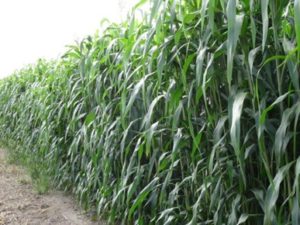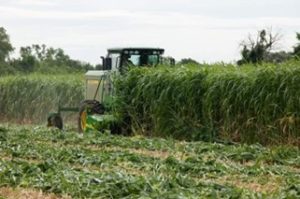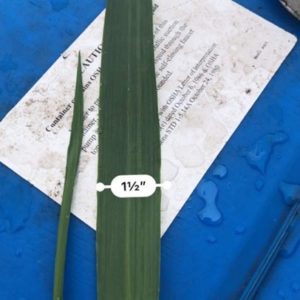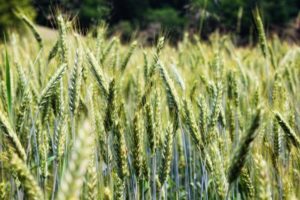Considerations for a Cover Crop Forage
At the 2024 Midwest Covers and Grains Conference, dairy farmer Daniel Olsen – owner of Forage Innovations – led a session on using cover crops as forage.
According to Daniel, starch and protein are easy to add to an animal’s diet if needed – simply buy more corn or soybeans. These ship and store very efficiently, whereas digestible fiber is bulky and takes up a lot of space. Because of this, Daniel says, “The most important thing that we can do is grow more pounds of digestible fiber per acre.”
The following is excerpted from Daniel’s presentation. (Note: the excerpts have been lightly edited for clarity and to match our house style.)
On Why He Advises Against Alfalfa
“The thing with alfalfa is that it doesn’t have a lot of fiber, and the digestibility of that fiber isn’t great. It contains 18% digestible fiber per pound. That means most of the fiber you fed the cow is not digested in the rumen – just made a lot of expensive manure.”
“If we take that alfalfa out and replace it with triticale and sorghum-sudangrass or a cocktail mix that’s higher in fiber – something with around 52% fiber and about 30% digestibility – that almost doubles the amount of digestible fiber. If you want to do grass-fed beef, if you want to feed your animals less concentrate – less purchased energies like shell corn – that’s a really important step.”
BMR Pearl Millet
“There have been millets in the industry forever, but most of them aren’t BMRs – brown mid-rib. Now, BMR is a gene – it’s not genetically modified. It’s a naturally occurring gene.”
“The brown mid-rib is the center line of leaf. What really impacts fiber digestibility is how much lignin is interlocked with that fiber. BMR plants actually don’t have that much less lignin than other plants – it’s just not interlocked with the fiber. It’s all in the mid-rib rather than spread throughout the plant, which improves digestibility.”
“If you’re planting any warm season crop – whether it’s sorghum, sudangrass, forage or sorghum millet – you should be planting a BMR. It’s sugarcane aphid tolerant and multi-harvest. You can cut it every 30 to 40 days, so you’re looking at maybe a three-cut system. It also doesn’t have prussic acid – which, if you’ve grazed sorghum or sorghum-sudangrass, you know can be a problem.”
BMR Forage Sorghum
“BMR for sorghum in a single-cut system can certainly work, and it can create large amounts of digestible fiber. While its fiber digestibility isn’t as high as millet, it has a larger fiber pool.”
“So, when you’re looking at growing crops for mature cows, this can be a great option. There are some aphid-tolerant varieties – they’re not as resistant as millet is, but some do show tolerance.”
BMR Sorghum-Sudangrass
“This is probably my favorite crop. I use a lot of photoperiod-sensitive (PPS) BMR sorghum-sudangrass. What makes it photoperiod-sensitive is that it doesn’t go reproductive based on maturity – it goes reproductive based on hours of daylight.”
“Until daylight drops below about 12 hours and 20 minutes of daylight, it doesn’t seed out. This keeps all the energy – in the form of sugar – in the plant, allowing it to build dry matter and sugars. It’s a great option after winter wheat, especially if you can get it in quickly by mid-July. You can grow a lot of feed in 60 or 90 days.”
Annual Rye
“There are some new European genetics that are extremely late maturing, which won’t head for maybe 40 days after a cutting. I’ve used those very successfully, but you have to be careful which annual ryegrass varieties you plant. A lot of them want to head out every 14 days, and that can become a problem.”
“They can also become a weed, so using late-maturing varieties allows you to capture them before there’s viable seed, which is a lot easier to manage.”
“But annual ryegrass is extremely high quality. It’s great to pair with warm-season crops, especially as we move farther north in the Midwest.”
Forage Oats
“I don’t use many regular grain oats, but I do use a lot of forage oats. They have a wide leaf and greater ability to put on dry matter while still maintaining quality. The leaf-to-stem ratio is much better, and we can combine them with a lot of different things – like ryegrass, triticale or rye.”
Triticale and Rye
“Triticale has more upside – both in yield and quality – but it also has more variability, especially in later fall plantings and low-fertility situations.”
“There’s a wider range of results with triticale, whereas rye is more consistent. Even though rye has much lower potential, its baseline is higher. Rye also matures so rapidly in the spring that it can be difficult to make good dairy-quality feed. In Wisconsin, it has something like a 15-minute harvest window.”
“Triticale, on the other hand, has a broader harvest window, and that’s largely because it tillers more. It’s denser, and those tillers tend to lag behind the main plant in maturity. So, even if some heads start to emerge, you’ve still got a lot of immature leaf material coming in behind, which helps moderate maturity.”






